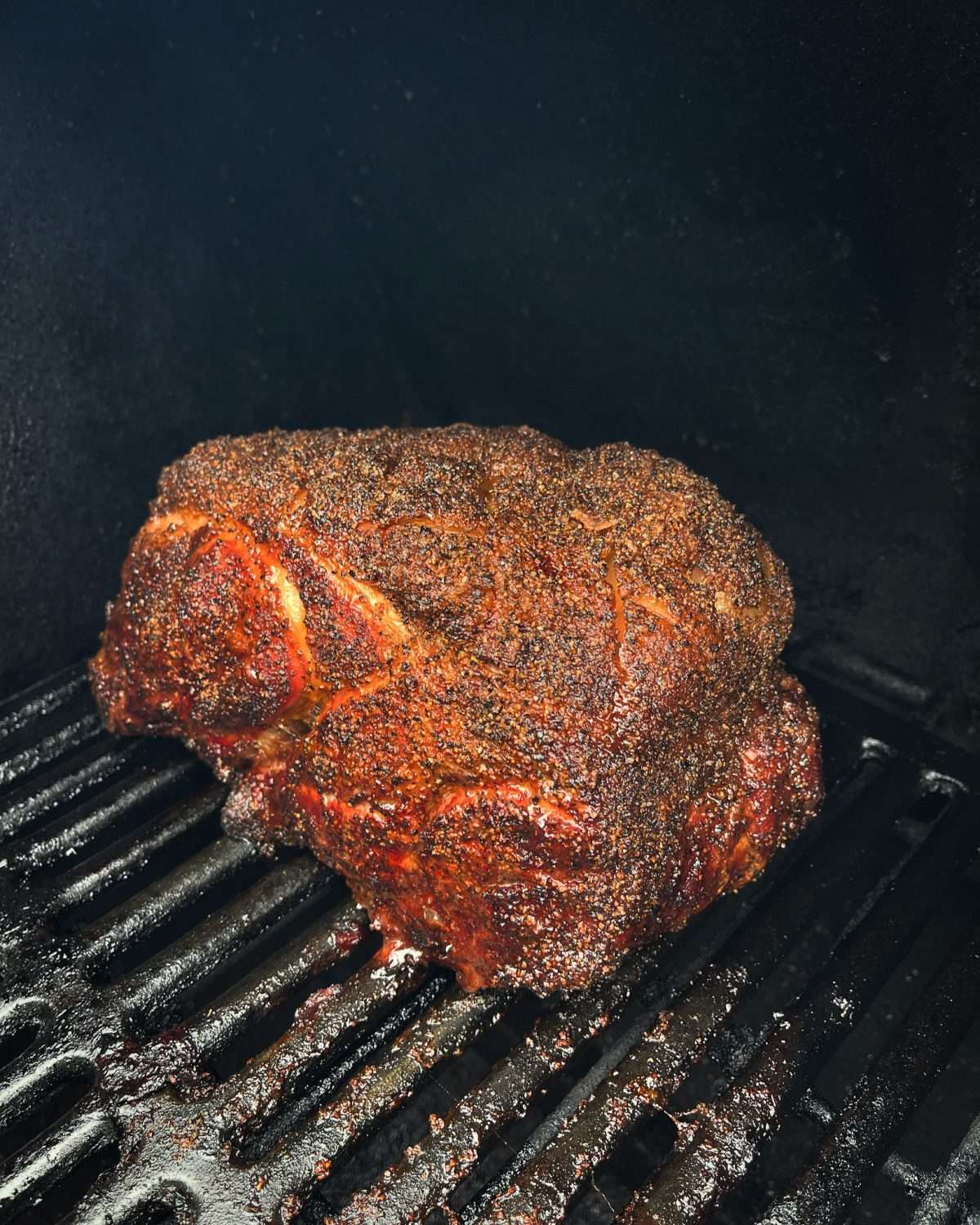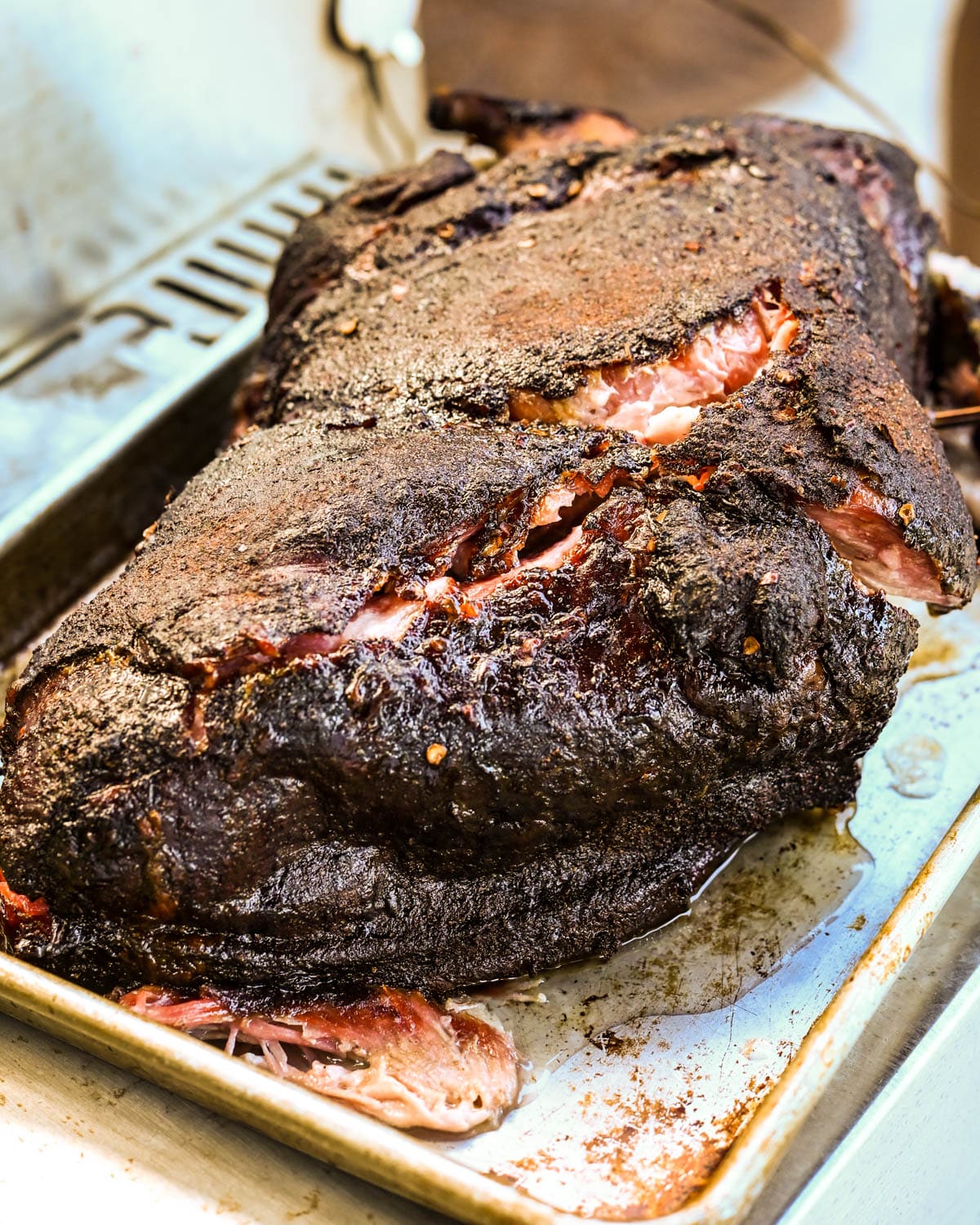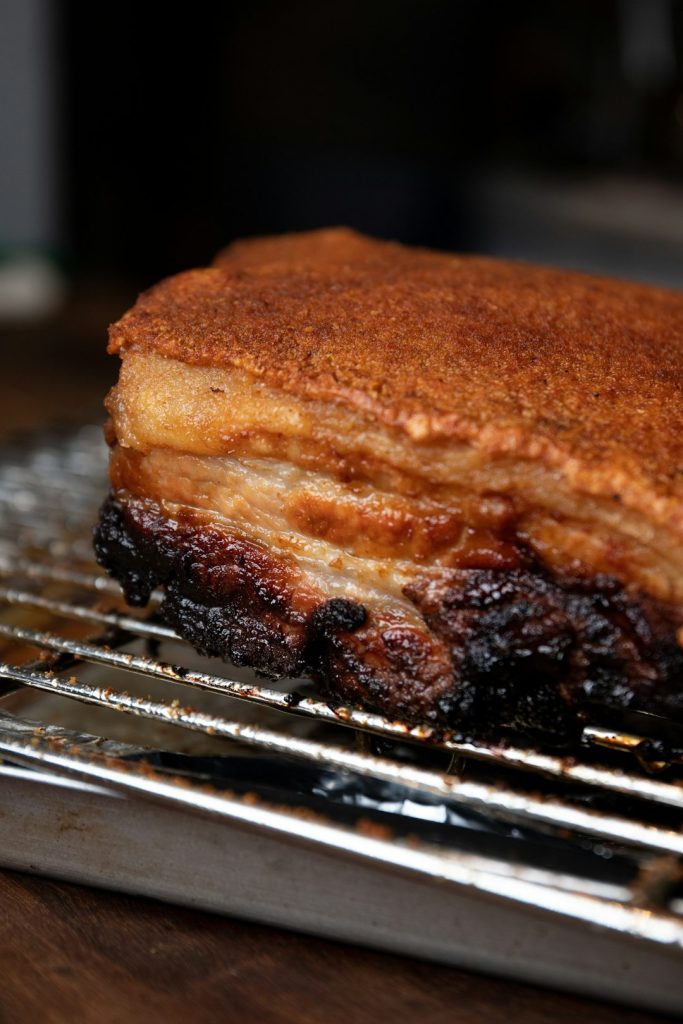Are you dreaming of that perfect pulled pork, tender and bursting with smoky flavors? Cooking pulled pork in a smoker can be a game-changer for your backyard BBQs.
But here’s the secret: getting the temperature just right. It’s the difference between pork that’s dry and chewy, and pork that’s juicy and melts in your mouth. You’ll discover the ideal temperature for smoking pulled pork, ensuring your next BBQ is unforgettable.
Let’s dive into the temperature tips that will make your pulled pork the star of your grilling season. Don’t miss out on transforming your smoker skills!

Credit: saltbuttersmoke.com
Choosing The Right Cut
Cooking pulled pork in a smoker needs the right cut of meat. The cut affects flavor and texture. It also changes cooking time and temperature.
Two popular cuts for pulled pork are pork shoulder and Boston butt. Knowing the difference helps you pick the best one for your smoker.
Pork Shoulder Vs. Boston Butt
Pork shoulder and Boston butt come from the same general area of the pig. Both have fat and connective tissue that break down during smoking. This makes the meat tender and juicy.
- Pork Shoulder:Comes from the lower part of the shoulder. It has more muscle and less fat.
- Boston Butt:Comes from the upper part of the shoulder. It has more marbling and fat.
- Cooking:Boston butt usually stays moister because of higher fat content.
- Flavor:Both cuts have rich pork flavor but Boston butt can taste richer due to fat.
Size And Weight Considerations
Choosing the right size affects cooking time and how the meat cooks in the smoker. Larger cuts take longer to cook evenly.
| Cut | Typical Weight | Ideal for |
| Pork Shoulder | 4 to 8 pounds | Small to medium gatherings |
| Boston Butt | 6 to 10 pounds | Medium to large gatherings |

Credit: www.reddit.com
Preparing The Pork
Cooking pulled pork in a smoker starts with proper preparation. This step ensures the pork stays juicy and flavorful while it cooks low and slow.
Focus on trimming excess fat and seasoning the meat well. You can also use marinades or dry rubs for added taste.
Trimming And Seasoning
Trim the pork shoulder by removing large fat pieces. Leave a thin fat layer to keep the meat moist during smoking.
- Use a sharp knife to cut away thick fat caps
- Remove silver skin or tough membranes
- Pat the meat dry with paper towels before seasoning
- Apply salt and pepper evenly over the surface
Seasoning early helps the flavors soak into the meat. Let the pork rest after seasoning for better taste.
Marinating And Dry Rubs
Marinating adds moisture and flavor. Dry rubs create a tasty crust on the pork.
| Type | Ingredients | Purpose |
|---|---|---|
| Basic Marinade | Apple cider vinegar, water, salt | Soften meat and add tang |
| Sweet Dry Rub | Brown sugar, paprika, salt, pepper | Add sweetness and color |
| Spicy Dry Rub | Cayenne, chili powder, garlic powder | Bring heat and depth |
| Herb Blend | Thyme, rosemary, salt, black pepper | Enhance aroma and flavor |
Apply marinades for at least 4 hours or overnight in the fridge. Cover the pork completely with dry rubs before smoking.
Setting Up The Smoker
Cooking pulled pork in a smoker takes time and care. Setting up your smoker properly helps the pork cook evenly and taste great.
Start by cleaning your smoker and checking fuel levels. This ensures steady heat and smoke throughout cooking.
Choosing Wood Types
Wood type changes the flavor of your pulled pork. Pick mild woods to avoid overpowering the meat.
Common woods for pork are fruit and hardwoods. They add a sweet or smoky taste to your meat.
- Apple wood gives a mild, sweet flavor
- Hickory adds a strong, smoky taste
- Cherry wood offers a fruity smoke
- Maple wood provides a light, sweet smoke
Maintaining Consistent Temperature
Keep your smoker temperature steady between 225°F and 250°F. This range cooks pulled pork slowly and tenderly.
Use a good thermometer to check the heat often. Adjust the vents or add fuel to keep the temperature steady.
- Open vents more to raise temperature
- Close vents slightly to lower temperature
- Add charcoal or wood as needed for fuel
- Use water pans to keep moisture and control heat
Ideal Smoking Temperature
Cooking pulled pork in a smoker needs the right temperature. It helps make the meat tender and full of flavor.
Choosing the ideal smoking temperature keeps the pork juicy and easy to pull apart.
Low And Slow Method
Smoking pulled pork at a low temperature for a long time is best. This method breaks down the meat’s fat and connective tissue.
- Keep smoker temperature between 225°F and 250°F.
- Plan to cook for 1.5 to 2 hours per pound of meat.
- Use wood like hickory or apple for good smoke flavor.
- Maintain steady heat without big temperature spikes.
Temperature Range For Tenderness
The internal temperature of the pork is key to tenderness. You want the meat to be soft but safe to eat.
| Internal Temperature | Effect on Meat |
| 160°F to 170°F | Meat starts to become tender but is still firm |
| 195°F to 205°F | Meat becomes very tender and easy to pull apart |
| Above 205°F | Meat may dry out if cooked too long |
Cooking Time Estimates
Knowing the right cooking time is key for tender pulled pork. The time depends on the weight and other factors. Using a smoker adds flavor but requires patience.
This guide helps you estimate how long to cook pulled pork in a smoker. It covers time per pound and what can change the cooking length.
Time Per Pound
Cooking time is often calculated by the weight of the pork shoulder. On average, it takes about 1.5 to 2 hours per pound at a steady smoker temperature of 225°F.
| Weight of Pork (lbs) | Estimated Cooking Time (hours) |
| 4 | 6 to 8 |
| 6 | 9 to 12 |
| 8 | 12 to 16 |
| 10 | 15 to 20 |
| 12 | 18 to 24 |
Factors Affecting Cooking Duration
Several things affect how long pulled pork takes to cook. These include the smoker type, weather, and meat condition.
- Smoker Temperature:Lower heat means longer cooking time.
- Meat Thickness:Thicker pieces take more time to cook through.
- Weather Conditions:Wind or cold can lower smoker heat and slow cooking.
- Fat Content:Fat can help keep meat moist but may change cooking speed.
- Wrapping Method:Using foil can speed up cooking by trapping heat.
Monitoring Internal Temperature
Cooking pulled pork in a smoker needs careful temperature checks. The inside of the meat must reach the right heat for safety and taste.
Watching the internal temperature helps you avoid undercooking or drying out the pork. This gives you tender and juicy pulled pork every time.
Using A Meat Thermometer
A meat thermometer is the best tool to check the pork’s temperature. Insert it into the thickest part of the meat, away from bone and fat.
Digital thermometers show the temperature quickly and clearly. Leave the thermometer in during smoking or check often without opening the smoker too much.
- Use an instant-read or probe thermometer
- Insert into the pork’s center
- Avoid touching bone or fat
- Check temperature every hour after 4 hours
Target Internal Temperature For Pulled Pork
Pulled pork needs a high internal temperature to break down tough fibers. The ideal target is between 195°F and 205°F (90°C to 96°C).
At this temperature, the pork is tender and easy to pull apart. Cooking to less than 195°F may make the meat tough and hard to shred.
| Temperature (°F) | Temperature (°C) | Result |
|---|---|---|
| 195°F – 205°F | 90°C – 96°C | Perfect for tender pulled pork |
| Below 195°F | Below 90°C | Meat may be tough |
| Above 205°F | Above 96°C | May dry out the pork |
Resting And Pulling The Pork
Cooking pulled pork in a smoker takes time and care. After cooking, resting the meat is very important. This helps keep the juices inside. Pulling the pork the right way makes it tender and easy to eat.
Understanding how to rest and pull the pork will improve your smoked meat. This guide explains why resting matters and how to pull the meat well.
Importance Of Resting
Resting the pork after smoking lets the juices settle. If you cut or pull it too soon, the juices will run out. This makes the meat dry and less tasty.
Resting also helps the meat finish cooking evenly. Keep the pork covered with foil or in a warm place. Rest for about 30 minutes to 1 hour before pulling.
- Juices stay inside the meat
- Meat becomes more tender
- Flavors get better and richer
- Meat finishes cooking evenly
Techniques For Pulling Meat
Pulling pork means breaking it into small, soft pieces. Use two forks or meat claws to pull the meat apart. Pull along the grain for the best texture.
Pull the pork gently to keep it juicy. Avoid shredding too fast or hard. Pulling the meat well makes it easier to eat and mix with sauces.
- Use two forks or meat claws
- Pull along the grain of the meat
- Work gently to keep juices inside
- Pull into bite-sized pieces
Common Mistakes To Avoid
Cooking pulled pork in a smoker needs careful temperature control. Many beginners make mistakes that affect the meat’s taste and texture.
Knowing what to avoid helps you get tender and juicy pulled pork every time. Here are common errors to watch out for.
Temperature Fluctuations
Keeping a steady smoker temperature is very important. Fluctuations cause uneven cooking and can dry out the pork.
Opening the smoker too often or using poor-quality fuel can make the heat go up and down.
- Check your smoker’s thermometer regularly.
- Use good charcoal or wood for consistent heat.
- Only open the smoker when needed to keep heat steady.
Overcooking And Dryness
Cooking pulled pork too long or at too high a temperature dries out the meat. It becomes tough and loses flavor.
Watch the internal temperature of the pork. Pull it off the smoker once it reaches about 195°F to 205°F for best results.
- Use a meat thermometer to track internal temperature.
- Avoid cooking above 250°F to keep meat juicy.
- Wrap the pork in foil if it looks too dry during cooking.
Serving Suggestions
Cooking pulled pork in a smoker is a slow process that brings out deep flavors. Serving it right makes your meal even better.
Here are some popular sides and sauce pairings to enjoy with your smoked pulled pork.
Popular Sides
Pulled pork pairs well with many side dishes. These sides add texture and balance the rich meat flavor.
- Coleslaw: Crunchy and creamy, it adds freshness.
- Baked beans: Sweet and smoky, they complement the pork.
- Macaroni and cheese: Soft and cheesy, a classic favorite.
- Cornbread: Slightly sweet, perfect for soaking up juices.
- Grilled vegetables: Light and healthy, they add color.
Sauce Pairings
Choosing the right sauce can enhance your pulled pork experience. Different sauces offer unique tastes.
- Classic BBQ sauce: Tangy and smoky, it matches well.
- Vinegar-based sauce: Sharp and thin, great for cutting fat.
- Mustard sauce: Slightly spicy and sweet, popular in some regions.
- Sweet and spicy sauce: Adds heat and sugar balance.
- Tomato-based sauce: Rich and smooth, a traditional choice.

Credit: www.garlicandzest.com
Frequently Asked Questions
What Is The Ideal Smoker Temperature For Pulled Pork?
The ideal smoker temperature for pulled pork is between 225°F and 250°F. This low and slow method ensures tender, juicy meat. Smoking at this temperature allows the connective tissues to break down properly, resulting in flavorful pulled pork.
How Long Should Pulled Pork Cook In A Smoker?
Pulled pork typically cooks for 1. 5 to 2 hours per pound at 225°F to 250°F. Total cooking time varies by meat size. Using a meat thermometer helps ensure the pork reaches the perfect internal temperature for shredding.
What Internal Temperature Is Best For Pulled Pork?
Pulled pork is best when cooked to an internal temperature of 195°F to 205°F. This range breaks down collagen for tender meat. Use a reliable meat thermometer to check doneness before pulling the pork.
Should I Wrap Pulled Pork During Smoking?
Wrapping pulled pork in foil or butcher paper around 160°F can help retain moisture. This technique, called the Texas Crutch, speeds up cooking and keeps the meat juicy. It’s optional but recommended for tender results.
Conclusion
Cooking pulled pork in a smoker needs the right temperature. Aim for about 225°F to 250°F for best results. This range helps the meat cook slow and become tender. Keep the temperature steady to avoid dry pork. Patience is key—low and slow wins the taste.
Check the meat’s internal temperature near 195°F to 205°F for perfect pull-apart texture. Remember, good pulled pork takes time, but it’s worth every minute. Enjoy the process and the delicious meal that follows.

